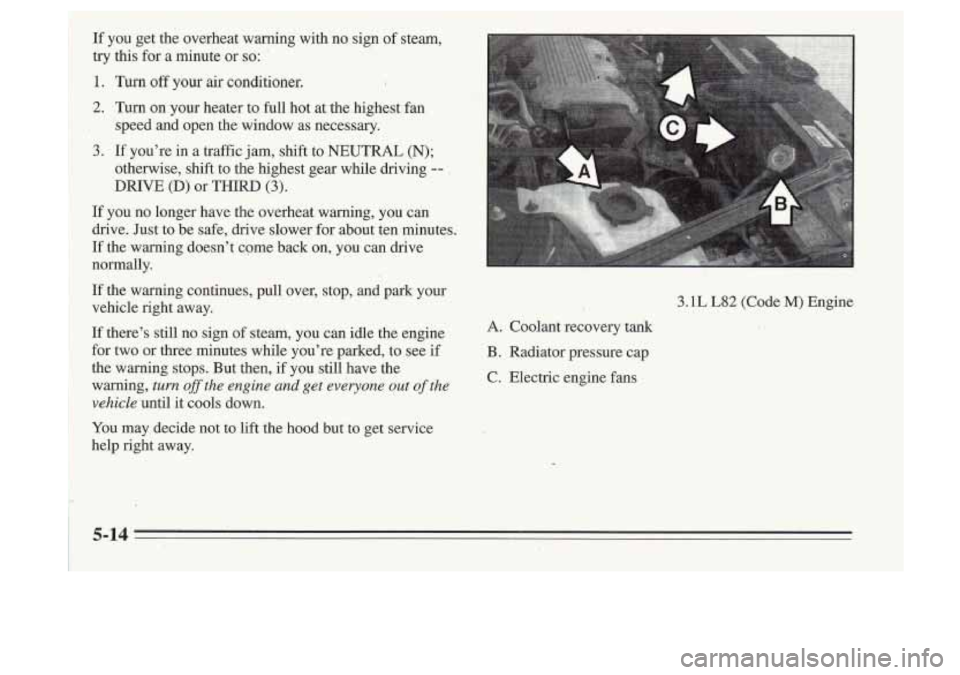Page 7 of 340
Vehicle Symbols
These are some of the symbols you may find on your vehicle.
3.
For example,
these sym%ols
are used on an
original battery:
POSSIBLE A
CAUTION
INJURY
PROTECT EYES BY
SHIELDING
CAUSTIC
BURNS
SPARKS
OR
FLAMES
SPARK
OR
FLAME ,I#$,
COULD
EXPLODE
BATTERY
These symbols are important
for you and
your passengers
whenever your vehicle is
driven:
POWER
WINDOW n-
These symbols
have to do with your lights:
SIGNALS e
TURN
pA;:z
pf
WARNING A
HAZARD
FLASHER
HIGH
LAMPSoR BEAM = =o
FOG LAMPS 3 0 '
These symbols
are on some
of
your controls:
WINDSHIELD
WIPER
'r' -4
WINDSHIELD 6$
WASHER I
WINDSHIELD
DEFROSTER
REAR
WINDOW
DEFOGGER
VENTILATING
b
. FAN
These symbols are used
on
warning and
indicator lights:
CHARGING ,I-1
BAllERY
SYSTEM
BRAKE
(a)
RADIATOR COOLANT
a
ENGINE OIL
PRESSURE Wh
. TEMP OIL
ANTI-LOCK
(@)
BRAKE
Here are some
other symbols
you may see:
FUSE
RADIO
k
VOLUME a
CONDITIONING AIR 43
LIGHTER k
SPEAKER
b
V
Page 108 of 340
Anti-Lock Brake System Active Light
When your anti-lock system
is adjusting brake pressure
to help avoid a braking skid,
the LOW TRAC light will
come on.
Slippery road conditions will exist if this light comes on,
so adjust your driving accordingly. The light will stay on
for a few seconds after the system stops adjusting brake
pressure.
The LOW TRAC light also comes on briefly, as a bulb
check, when the engine is started. If the light doesn’t
come on then, have it fixed
so it will be there to tell you
when the system is active.
‘ This light tells.you that
your engine coolant has
, overheated or your radiator
cooling fan is not working.
If you have been operating your vehicle under normal
driving conditions, you should pull
off the road;stop’
your vehicle and turn.off the engine as soon as possible.
Hot Coolant Can Burn You Badly!
In “Problems on the~Road,” this manual shows what to
do. See “Engine Overheating”
in the Index.
2-50
Page 186 of 340

If you get the overheat warning with no sign of steam,
tw this for a minute or
so:
1. Turn off your air conditioner.
2. Turn on your heater to full hot at the highest fan
3. If you're in a traffic jam, shift to NEUTRAL (N);
speed and open the window as necessary.
otherwise, shift to the highest gear while driving
--
DRIVE (D) or THIRD (3).
If you no longer have the overheat warning, you can
drive. Just to be safe, drive slower for about ten minutes.
If the warning doesn't come back on, you can drive
normally.
If the warning continues, pull over, stop, and park your vehicle right away.
3.1L L82 (Code M) Engine
If there's still no sign of steam, you can idle the engine
for two or three minutes while you're parked, to see if
B. Radiator pressure cap
the warning stops. But then, if you still have the warning,
turn off the engine and get everyone out of the
vehicle
until it cools down.
You may decide not to lift the hood but to get service
help right away.
A. Coolant recovery tank ,
C. Electric engine fans
5-14
Page 187 of 340
3.4L LO1 (Code X) Engine Y The coolant level should be at or above the COLD mark.
If it isn’t, you may have a leak in the radiator hoses,
heater hoses, radiator, water
pump or somewhere else in
the
cooling system.
If the coolant inside the coolant recovery tank is boiling,
don’t do anything else (until it
cools down.
5-15
Page 189 of 340
NOTICE:
In cold weather, water can freeze and crack,,the ... , . i . ar
engine, radiator, heater core and other parts.' Use
the recommended coolant.
When the coolant in the coolant recovery tank is at the
COLD mark, start your vehicle.
If the overheat warning continues, there's one more
thing you can try.
You can add the proper coolant mix
directly to the radiator, but be sure the cooling system is
cool before you do it.
5-17
Page 190 of 340
NOTICE:
Your engine has a specific radiator fill procedure.
Failure
to follow this procedure could cause your
engine
to overheat and be severely damaged.
1. You can remove the
radiator pressure cap
when the
cooling
system, including the
radiator pressure cap
and upper radiator
hose,
is no l6nger
hot.
Turn the pressure
cap slowly to theleft
until
it first stops.
(Don’t press down
while turning.the
pressure cap.)
-
If you hear a hiss, wait for that to stop. A hiss means
there is still some pressure left.
,5-18 ..
Page 192 of 340
3.4L LQ1 (Code X) Engine
They are located
on the thermostat housing and heater
inlet pipe.
1 3.4L V6 (VIN Code X): There are two bleed valves.
4. Fill the radiator
with the proper
mix,
up. to the base
of the 'filler neck.
If
you see a stream.of coolant coming from an air
bleed valve, close the valve. Otherwise, close the-
valves after the radiator i.s filled.
5. Rinse or wipe any spilled coolant from the engine
and compartment.
Page 193 of 340
6. Then fill the coolant recovery tank to the COLD
7. Put the cap back on the coolant recovery tank, but
mark.
-
leave the
radiator pressure cap off.
8. Start the engine 'and let it run until you can feel the
upper radiator hose getting hot. Watch out for the
engine fans.
filler neck may be lower. If the level
is lower, add
more of the proper
mix through the filler neck until
the level reaches the base of the filler neck.
9. By this time the coolant level inside the radiator
5-21 ~.